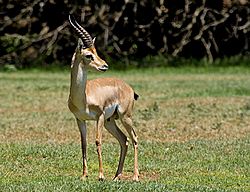Mountain gazelle facts for kids
Quick facts for kids Mountain gazelle |
|
|---|---|
 |
|
| Mountain gazelle (male) | |
| Conservation status | |
| Scientific classification | |
| Kingdom: | |
| Phylum: | |
| Class: | |
| Order: | |
| Family: | |
| Subfamily: |
Antilopinae
|
| Genus: | |
| Binomial name | |
| Gazella gazella (Pallas, 1766)
|
|
The mountain gazelle (Gazella gazella) is a type of gazelle. These animals live in parts of Egypt, Palestine, Turkey, and across the Arabian Peninsula. You can find them in mountains, hills, and flat areas near the coast. The mountain gazelle is the national animal of Palestine.
Contents
Physical Features
Mountain gazelles are special because both male and female gazelles have horns. However, the males have much bigger horns with rings around them. Female gazelles also have horns, but they are thinner and shorter.
Males are also generally larger than females. A wild male can weigh between 17 and 29.5 kilograms (about 37-65 pounds). Females are a bit lighter, weighing 16 to 25 kilograms (about 35-55 pounds). Mountain gazelles are very fast, able to run up to 80 kilometers per hour (about 50 miles per hour)!
Where They Live and How Many There Are
Most mountain gazelles live in Israel. You can also find them in parts of Jordan and Turkey. It's hard to know exactly how many are left in the wild. Experts in Israel believe there are only about 3,100 of these endangered gazelles in their country.
Overall, fewer than 3,000 mountain gazelles remain in their natural homes.
Their Home Environment
Gazelles are good at living in dry, desert-like places. They often spend their time on top of mountains and hills. The average temperature where they live is around 21-23 degrees Celsius (70-73 degrees Fahrenheit).
To avoid the heat during the day, gazelles prefer to rest on hilltops. Around sunrise and sunset, they move down the hills to eat. They look for food in light forests, open fields, or desert plateaus.
Mountain gazelles are not as good at handling very hot, dry weather as the Dorcas gazelle. This is why Dorcas gazelles might have taken over some of the mountain gazelle's territory during a warmer period long ago.
Daily Life
Mountain gazelles are active during the day and sleep at night. They are also quite protective of their areas and their small groups. They usually live in herds of three to eight individuals.
There are three main types of groups you might see:
- Herds of mothers and their young.
- Herds of young male gazelles.
- Single male gazelles who have their own territory.
Life Cycle and Reproduction
In the wild, mountain gazelles usually don't live past eight years old. But if they are cared for by humans, they can live up to 15 years.
Female gazelles can start having babies when they are about 12 months old. Males can start breeding when they are around 18 months old. Mountain gazelles do not stay with one partner for life. Their main breeding season is in the early winter months.
Females usually give birth to one baby (called a fawn) each year, mostly in April or May. A few days before giving birth, the mother will leave her herd and stay by herself. The mother and her fawn will stay alone for up to two months. During this time, the mother keeps a close watch for predators. Common animals that might try to attack a young fawn include foxes, jackals, and wolves.
Young male fawns will stay with their mother for about six months before joining a herd of other young males. Young female fawns sometimes stay with their mother and join her herd.
What They Eat
Mountain gazelles often live in the same areas where acacia trees grow. They mostly eat grass, but this can change depending on what food is available. They can go for a long time without drinking water. Instead, they get the water they need from juicy plants and dew drops on leaves.
Images for kids
See also
 In Spanish: Gacela arábiga para niños
In Spanish: Gacela arábiga para niños



